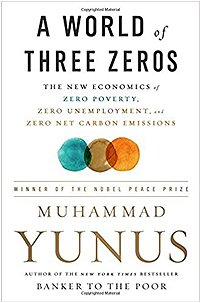A rebuttal of the criticism of microfinance
In recent days, much has been written on the benefits (or lack thereof) of microfinance (micro-credit). Some writers are economists and others simply interested in the subject who have based their opinions on research conducted by economists on microfinance in Bangladesh and abroad. Authors who have been critical of microfinance use several strategies to undermine the case of micro-credit as an instrument of poverty alleviation.
One strategy is to first set up a straw man to easily demolish the argument that microfinance benefits the poor. The critics began by making the exaggerated claim that pioneers like Professor Muhhamad Yunus of the Grameen Bank (GB) have said (or implied) that microfinance alone can overcome poverty, and result in a developed, poverty-free economy.
The problem with this approach is that it is patently untrue. Prof Yunus who completed his doctoral dissertation under the renowned economist N. Georgescu Roegen at Vanderbilt University knows about econometrics and measurement methodologies used by academic economics. He has never made the claim that micro-credit is the "magic bullet" that will solve all problems of underdevelopment and poverty. Similarly, no one in the wider micro-credit industry has taken the position that standard growth strategies such as macroeconomic reforms, promoting industrialization, export promotion, and investment in education are ineffective tools for economic development or poverty alleviation.
To my knowledge, none has made the claim that microfinance is superior to macroeconomic tools for poverty alleviation and economic growth. In his 2008 book, Creating a World Without Poverty, Yunus wrote of the significance of foreign direct investment for industrialization, duty-free access for Bangladesh exports, and access to foreign labour markets for remittance income flows (page: 103-128). This shows that this particular criticism is without merit.
Without microfinance institutions such as the Grameen Bank, the poor would have no access to institutional finance, and would be left at the mercy of the village money lenders. It is true that not every borrower of a micro- loan is going to be successful. No model or strategy is perfect. Some would fail, and get caught in a debt trap. But let us not forget that in the case of GB, nearly a billion dollars is borrowed by over 8 million poor households each year. How many cases of distress have we heard? On the contrary, there are many millions of instances of lives rebuilt and lives changed. The global impact is improvements in the lives of more than 100 million poor, and growing.
Second, some critics point out that although a few researchers have found a positive impact on borrower's incomes, others have been unable to detect any measurable positive long-term impact. Worse, a few case studies have found increasing indebtedness, and the newspapers carry stories of distress among borrowers. Others report on how husbands would take advantage of the new funds and spend on consumption rather than investing these, or that borrowers would take out a second loan from a competing microfinance organization to pay back the first loan. Given these abuses, the critics claim that microfinance is ineffective and a waste of valuable development dollars.However, this conclusion is unwarranted. There are several problems with this view. As mentioned above, there is no denying the fact that given the very large number of borrowers, some will fail. The same is true of commercial bank borrowers. Also, given the plethora of NGOs many poorly managed, many do not strictly follow the principles developed by the GB, there is failure, waste and abuse. This should not surprise anyone. When you have 8.5 millions borrowers as is the case of the Grameen Bank, even one per cent default would mean nearly 85,000 failures. But let us keep the numbers in perspective. The comparison should not be against some perfect standard (100%) but the existing models.
For example, what is the success rate of the commercial banks operating mostly in the cities? What about the persistently high default rates experienced by the Krishi (Agriculture) Bank? Globally, consider the hundreds of billions of dollars lost by banks in the developed nations in the 2008-2009 global financial and economic crisis from the real estate bubble. Given these national and international benchmarks, the stability and success of the GB and other microfinance agencies seem remarkable.
It is simply hypocritical to criticize microfinance organisations for some failures, without doing the same for the commercial banks. Has anyone recommended that we do away with the commercial banks?
Other critics set up an impossibly high standard to judge the merits of microfinance institutions. For example, they ask about the impact of GB in a manner that presents a double standard. Do these authors ask if commercial banks reduce poverty? It is a legitimate question. Why is this not asked? Microfinance is simply providing some "modern banking services" to the marginal and the poor! Suppose we cannot find measureable impact of commercial banks on poverty alleviation. Will we then recommend that commercial banks should not be allowed to operate since some borrowers fail and others fall in debt, or not benefited? It is easy to forget that the poor women who work in our homes or in the garment factories or those who live in the villages need the same banking services we are so used to. They too are interested in saving, investing, and creating new sources of incomes. Why begrudge this? This is truly a matter of "Haves" and "Have-Nots." Several billion low-income in the world have no access to traditional banking services. Can we imagine living without access to banking even for a week?
Third, no matter how successful the micro-credit programme is, given the trails and errors associated with an innovative programme, there will always be some failures, errors in the learning process. For example, how do you deal with a massive natural disaster that has wiped out the homes and livelihood of millions as has happened during the 1998 floods in Bangladesh.
The GB had to temporarily halt all repayments for a period of time to allow the borrowers to regroup. The important learning from that experience has resulted in not just loans, but several new financial instruments such as mandatory savings, and life insurance. For Professor Yunus and his team, it took many years of experimentation to reach the present model. It is not easy to build programmes that can change the lives for so many for the good.
Fourth, many commentators have been critical that micro-credit organizations charge high, even usurious interest rates, and are exploitative of the poor.
This is untrue. The facts are clear if one cares to do the research. The GB, like all micro-credit bodies in Bangladesh, is regulated and cannot charge any rate it would like to. The GB is approved to charge a maximum interest rate of 27 per cent interest rate annually (market rate plus a mark up for higher admin costs of making small loans). This is a legal cap that must be followed by all microfinance groups in Bangladesh. However, the maximum interest rate that the GB charges is 20 per cent (7.0 per cent below what it is approved to charge). For some type of loans, it charges even less, much less - 8.0 per cent for housing loans, 5.0 per cent for educational loans, zero per cent interest for loans in the beggar programme!
All of this information is freely available, and the myth persists that the GB and other microfinance bodies charge usurious rates. This was recently confirmed by an audit by an international transparency organization that specializes in NGO audits. It is a wonder, how people ignore the facts once they have set their opinions.
Is 20 per cent interest rate annually too high? Is it usurious? The answer depends on what is the scale of comparison and what is the alternative. One cannot conclude that these rates are too high without a benchmark. If 20 per cent sounds high compared to what we pay for a commercial bank loan, consider the additional human and administrative costs of taking banking services to the poor in the remote villages. This is why none of the commercial banks seemed interested in the poor and low-income customers, even after 30 years of success of the GB and BRAC and other organizations involved successfully in microfinance. Also, benchmark this against what the money lender would charge in a village - 100 per cent or higher!
One can also argue that since the GB is actually owned by its borrowers and members, the profits flow right back to the poor. Poverty alleviation is the mission of the GB. The final point in villages where micro-credit banks do not exist, the poor have no recourse to institutional credit and have to depend on money lenders who would charge much higher and exploitative rates. Which is better?
Instead of tearing down what is truly a great success story, the need of the hour is constructive criticism and support. How can we improve the existing models of non-profit microfinance? Can we build a model of profit microfinance that is not exploitative and abusive of the poor clientele? How can we increase the impact of small loans on savings, productivity and incomes? How can we attract more global investors to create social businesses where helping the poor remains the focus? How can we complement and supplement this proven anti-poverty programme with tax and macroeconomic reforms to release the entrepreneurial talents throughout the economy, industrialize, export and create wealth? How can we use the tools of all social sciences - economics, sociology, anthropology, psychology - to come up with better measurement tools to benchmark the true impact of this and other innovative anti-poverty programs.
The writer is a professor of economics and dean of a business school in the US. He welcomes comments and feedback at e-mail : muquddus@pvamu.edu
Source: http://www.thefinancialexpress-bd.com/more.php?news_id=131472&date=2011-04-05


